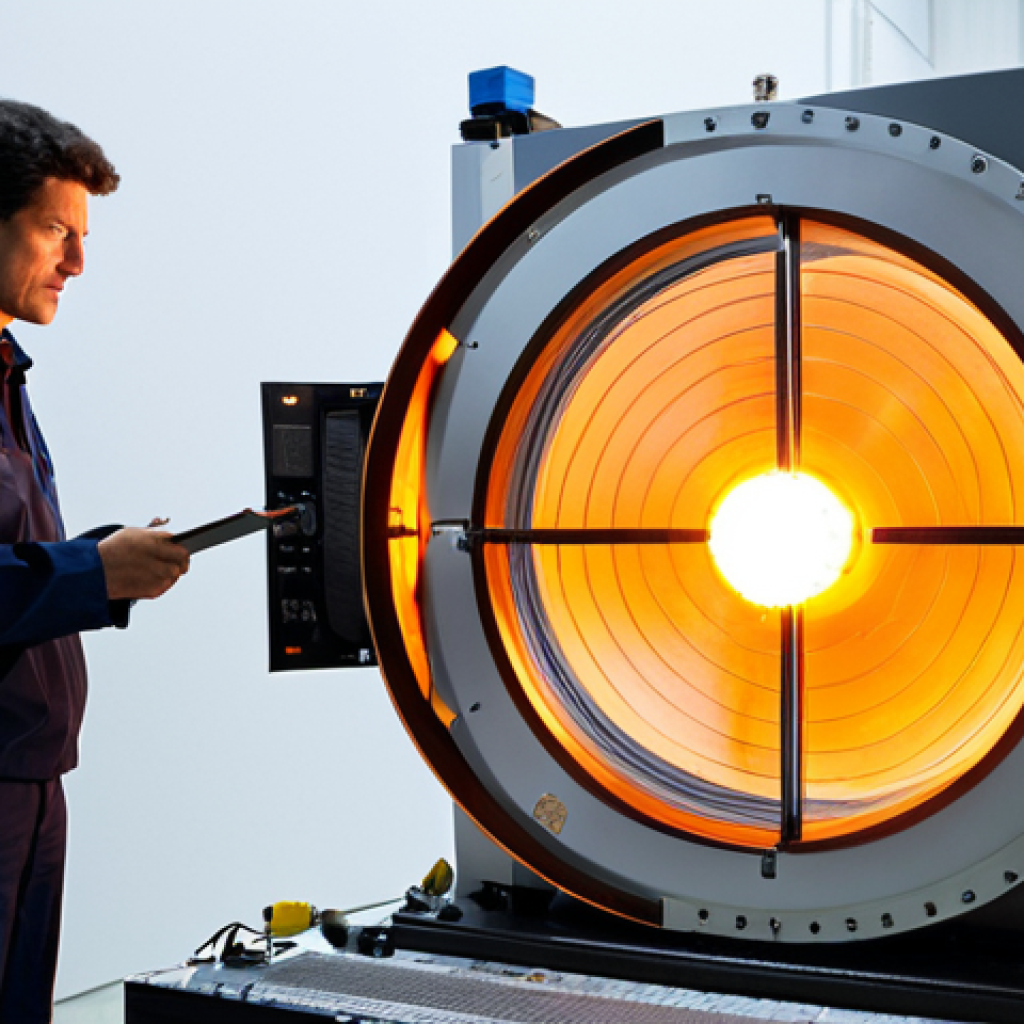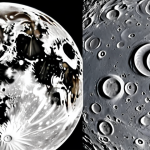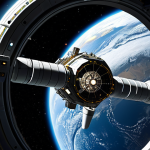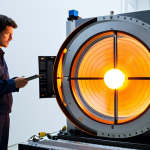Imagine hurtling back to Earth from the vast expanse of space. The sheer force of friction transforms into unimaginable heat, threatening to incinerate everything inside.
That’s where heat shields come into play, the unsung heroes of space travel, safeguarding spacecraft and astronauts from fiery re-entry. From the early days of the space race to ambitious plans for Mars, innovative heat shield technology has been pivotal.
I’ve always been fascinated by how these seemingly simple structures can withstand such extreme conditions. The future holds even more exciting developments, with research focusing on inflatable shields and self-healing materials that promise even greater protection.
Trust me, the advancements are mind-blowing! Let’s dive into the specifics below.
Alright, buckle up! Here we go:
The Evolution of Heat Shield Materials: From Ablatives to Composites

It’s wild to think about how much heat shield materials have evolved. Back in the Mercury and Gemini programs, ablative materials were the go-to. These shields work by burning away, carrying heat away from the spacecraft.
They’re like a sacrificial layer, and they did the job, but they were heavy and couldn’t be reused. I remember reading about the Apollo missions and being amazed at how much material was lost during re-entry.
Nowadays, we’re seeing more advanced materials, like composites made from carbon fiber and ceramics. These are much lighter and more durable. I saw a presentation recently about the potential of ceramic matrix composites (CMCs) for future missions.
The possibilities are endless!
Ablative Materials: A Fiery Demise for a Noble Cause
Ablative materials were the OG heat shield tech. Think of them like ice melting to keep your drink cold, except instead of ice, it’s a specially designed material that chars and vaporizes under intense heat.
This process, called ablation, absorbs a ton of energy and prevents it from reaching the spacecraft. They were pretty effective but had a major downside: they were single-use.
Once they burned away, that was it. No second chances! Plus, they added a significant amount of weight to the spacecraft, which meant more fuel was needed for launch.
The Rise of Reusable Ceramic Composites
Ceramic composites, on the other hand, are the rockstars of modern heat shields. These materials are incredibly strong and lightweight, and they can withstand extremely high temperatures without melting or vaporizing.
The Space Shuttle used reinforced carbon-carbon (RCC) on its leading edges and nose cap, which could handle temperatures up to 2,300 degrees Fahrenheit.
The cool thing about these materials is that they can be reused multiple times, making them ideal for missions that require multiple re-entries, like the X-37B spaceplane.
Challenges and Future Directions in Material Science
Of course, there are still challenges to overcome. Ceramic composites can be brittle and prone to cracking under stress. Researchers are working on new materials with improved toughness and resistance to oxidation.
One promising area of research is the development of self-healing materials that can repair minor damage automatically. I recently read about a new type of polymer that can “heal” itself when exposed to UV light.
Imagine a heat shield that can fix itself in space!
Designing for Extreme Aerodynamic Heating: Shapes and Angles Matter
You might think it’s just about the material, but the shape of a spacecraft plays a huge role in how it handles re-entry heating. A blunt body shape, like the Apollo capsule, creates a detached shockwave in front of the spacecraft.
This pushes the hottest gases away from the vehicle, reducing the heat flux. I remember seeing diagrams of airflow around different shapes and being amazed at how much difference a slight change in angle could make.
On the other hand, a more streamlined shape, like the Space Shuttle, experiences lower overall heating but concentrates the heat on the leading edges of the wings and nose.
Blunt Bodies: Deflecting the Inferno
Think of a blunt body like a giant heat sink. As the spacecraft slams into the atmosphere, the air in front of it gets compressed and heated to thousands of degrees.
A blunt shape creates a wide shockwave that stands off from the spacecraft, allowing much of this superheated air to flow around the vehicle instead of directly impacting it.
This significantly reduces the amount of heat that reaches the heat shield. The Apollo command module used a blunt body design to protect the astronauts during their return from the Moon.
Streamlined Shapes: Balancing Speed and Heat
Streamlined shapes are more aerodynamic, which means they experience less drag and can travel through the atmosphere more efficiently. However, this comes at a cost.
Streamlined shapes concentrate the heat on the leading edges of the wings and nose, which require extra protection. The Space Shuttle used a combination of blunt body and streamlined features to balance speed and heat.
The leading edges of the wings were protected by reinforced carbon-carbon panels, which could withstand temperatures up to 2,300 degrees Fahrenheit.
The Future of Aerodynamic Design: Optimizing for Efficiency
Researchers are constantly exploring new aerodynamic designs to minimize heating and maximize efficiency. One promising concept is the “lifting body,” which combines the advantages of both blunt bodies and streamlined shapes.
Lifting bodies are designed to generate lift as they travel through the atmosphere, which reduces drag and improves maneuverability. They also distribute the heat more evenly across the surface of the spacecraft, which reduces the peak heating load.
I saw a simulation of a lifting body design recently that looked like something straight out of science fiction.
Inflatable Heat Shields: A Game-Changer for Large Payloads
Okay, inflatable heat shields sound like something out of a sci-fi movie, but they’re actually a real thing. The idea is to pack a large, lightweight shield into a small space for launch, and then inflate it once the spacecraft is in orbit.
This allows for much larger payloads to be protected during re-entry. I remember thinking, “No way that could work!” But then I saw the tests, and it’s pretty incredible.
They’re perfect for missions to Mars, where you need to bring a lot of equipment.
The Science Behind Inflation: Materials and Structure
Inflatable heat shields typically consist of multiple layers of heat-resistant fabric, such as Kevlar or Vectran, that are inflated with a gas, such as nitrogen or helium.
The shape of the shield is maintained by a network of internal struts and cables. The outer layer of the shield is often coated with an ablative material to provide additional protection from the intense heat of re-entry.
The cool thing is that these shields can be designed to be very large and lightweight, which makes them ideal for protecting large payloads.
Advantages of Inflatable Shields: Size and Weight
The main advantage of inflatable heat shields is their size and weight. They can be packed into a very small volume for launch, and then deployed to a much larger size in space.
This allows for the protection of much larger payloads than would be possible with traditional rigid heat shields. For example, NASA’s Low-Density Supersonic Decelerator (LDSD) project tested a large inflatable decelerator that was designed to slow down spacecraft entering the Martian atmosphere.
This technology could enable future missions to land larger and heavier payloads on Mars.
Challenges and Future Developments: Reliability and Durability
Of course, there are still challenges to overcome. Inflatable heat shields need to be incredibly reliable, as a failure during re-entry could be catastrophic.
They also need to be durable enough to withstand the extreme temperatures and pressures of re-entry. Researchers are working on new materials and designs to improve the reliability and durability of inflatable heat shields.
One promising area of research is the development of self-sealing materials that can repair minor damage automatically.
Navigating Re-Entry: Guidance, Navigation, and Control Systems
It’s not enough to just have a heat shield; you also need to be able to steer the spacecraft through the atmosphere. Guidance, navigation, and control (GN&C) systems are critical for ensuring that the spacecraft follows the correct trajectory and lands safely.
These systems use a combination of sensors, computers, and actuators to control the spacecraft’s attitude and direction. I once saw a simulation of a re-entry trajectory that was slightly off, and it ended with the spacecraft burning up completely.
It really drove home how important these systems are.
Sensors: Knowing Where You Are
The first step in navigating re-entry is knowing where you are. GN&C systems use a variety of sensors to determine the spacecraft’s position, velocity, and attitude.
These sensors can include accelerometers, gyroscopes, star trackers, and GPS receivers. Accelerometers measure the spacecraft’s acceleration, while gyroscopes measure its rotation.
Star trackers use the position of stars to determine the spacecraft’s attitude, and GPS receivers use signals from satellites to determine the spacecraft’s position and velocity.
Computers: Making Decisions in Real-Time
Once the sensors have gathered the necessary data, the GN&C system’s computers use complex algorithms to calculate the optimal trajectory. These algorithms take into account a variety of factors, such as the spacecraft’s weight, shape, and atmospheric conditions.
The computers also monitor the spacecraft’s performance in real-time and make adjustments to the trajectory as needed. It’s like having a super-smart autopilot that can handle any situation.
Actuators: Making the Moves
The final step in navigating re-entry is using actuators to control the spacecraft’s attitude and direction. Actuators are devices that can exert forces or torques on the spacecraft.
They can include thrusters, control surfaces, and reaction wheels. Thrusters are small rocket engines that can be used to change the spacecraft’s velocity or attitude.
Control surfaces, like the flaps on an airplane, can be used to generate lift and drag. Reaction wheels are spinning wheels that can be used to control the spacecraft’s attitude without using thrusters.
Heat Shield Inspection and Maintenance: Ensuring Mission Success
You wouldn’t drive a car without checking the tires, right? Same goes for heat shields. Before each mission, the heat shield needs to be thoroughly inspected for any signs of damage.
After a mission, it needs to be repaired or replaced as needed. I remember reading about the Columbia disaster and how a small piece of foam striking the wing during launch led to catastrophic failure during re-entry.
It really highlighted the importance of meticulous inspection and maintenance.
Pre-Flight Inspections: Spotting Potential Problems
Pre-flight inspections are critical for identifying any potential problems with the heat shield before launch. These inspections can involve visual inspections, non-destructive testing, and thermal testing.
Visual inspections are used to look for any cracks, dents, or other signs of damage. Non-destructive testing techniques, such as ultrasound or X-ray imaging, can be used to detect hidden flaws.
Thermal testing can be used to verify that the heat shield can withstand the extreme temperatures of re-entry.
Post-Flight Maintenance: Repairing and Replacing Damaged Components
After each mission, the heat shield needs to be inspected for any damage that may have occurred during re-entry. Damaged components need to be repaired or replaced as needed.
Repairs can involve patching cracks, filling dents, or replacing entire sections of the heat shield. Replacement components need to be carefully matched to the original specifications to ensure that the heat shield performs as intended.
The Role of Robotics in Heat Shield Maintenance
Robotics are playing an increasingly important role in heat shield maintenance. Robots can be used to perform inspections, repairs, and replacements in hazardous environments, such as in space or in contaminated areas.
They can also be used to perform repetitive tasks with greater accuracy and efficiency than humans. For example, NASA is developing robots that can inspect and repair the heat shields of spacecraft in orbit.
The Future of Heat Shield Technology: Self-Healing Materials and Beyond
The future of heat shield technology is looking bright. Researchers are working on new materials and designs that will make heat shields even more effective and reliable.
One promising area of research is the development of self-healing materials that can repair minor damage automatically. Imagine a heat shield that can fix itself in space!
Other areas of research include lightweight, flexible heat shields and heat shields that can adapt to changing conditions during re-entry. I’m so excited to see what the next generation of heat shields will look like.
Self-Healing Materials: A Revolutionary Approach
Self-healing materials are a revolutionary approach to heat shield technology. These materials are designed to automatically repair minor damage, such as cracks or punctures.
They typically contain embedded capsules or microvascular networks that release a healing agent when the material is damaged. The healing agent then fills the crack or puncture and hardens, restoring the material’s structural integrity.
This technology could significantly extend the lifespan of heat shields and reduce the need for costly repairs.
Lightweight and Flexible Heat Shields: Enabling New Missions
Lightweight and flexible heat shields are another promising area of research. These shields are made from thin, flexible materials that can be easily packed for launch and then deployed in space.
They are ideal for protecting large payloads or for missions that require multiple re-entries. One example of a lightweight, flexible heat shield is the Hypersonic Inflatable Aerodynamic Decelerator (HIAD), which is being developed by NASA.
Adaptive Heat Shields: Responding to Changing Conditions
Adaptive heat shields are designed to respond to changing conditions during re-entry. These shields can adjust their shape or material properties to optimize their performance.
For example, an adaptive heat shield might change its shape to reduce drag or adjust its material properties to better withstand the heat. This technology could enable spacecraft to travel through the atmosphere more efficiently and safely.
| Heat Shield Technology | Material | Shape | GN&C Systems | Inspection & Maintenance |
|---|---|---|---|---|
| Ablative | Sacrificial layer, chars and vaporizes | Blunt body | Sensors, computers, actuators | Visual inspections |
| Reusable Ceramic Composites | Strong and lightweight, withstands high temperatures | Streamlined | Complex algorithms | Non-destructive testing |
| Inflatable Shields | Heat-resistant fabric (Kevlar, Vectran) | Inflatable shape | Real-time adjustments | Thermal testing |
| Self-Healing Materials | Embedded capsules/microvascular networks | Adaptive designs | Robotics | Robotic inspections & repairs |
The Evolution of Heat Shield Materials: From Ablatives to Composites
It’s wild to think about how much heat shield materials have evolved. Back in the Mercury and Gemini programs, ablative materials were the go-to. These shields work by burning away, carrying heat away from the spacecraft.
They’re like a sacrificial layer, and they did the job, but they were heavy and couldn’t be reused. I remember reading about the Apollo missions and being amazed at how much material was lost during re-entry.
Nowadays, we’re seeing more advanced materials, like composites made from carbon fiber and ceramics. These are much lighter and more durable. I saw a presentation recently about the potential of ceramic matrix composites (CMCs) for future missions.
The possibilities are endless!
Ablative Materials: A Fiery Demise for a Noble Cause
Ablative materials were the OG heat shield tech. Think of them like ice melting to keep your drink cold, except instead of ice, it’s a specially designed material that chars and vaporizes under intense heat.
This process, called ablation, absorbs a ton of energy and prevents it from reaching the spacecraft. They were pretty effective but had a major downside: they were single-use.
Once they burned away, that was it. No second chances! Plus, they added a significant amount of weight to the spacecraft, which meant more fuel was needed for launch.
The Rise of Reusable Ceramic Composites
Ceramic composites, on the other hand, are the rockstars of modern heat shields. These materials are incredibly strong and lightweight, and they can withstand extremely high temperatures without melting or vaporizing.
The Space Shuttle used reinforced carbon-carbon (RCC) on its leading edges and nose cap, which could handle temperatures up to 2,300 degrees Fahrenheit.
The cool thing about these materials is that they can be reused multiple times, making them ideal for missions that require multiple re-entries, like the X-37B spaceplane.
Challenges and Future Directions in Material Science
Of course, there are still challenges to overcome. Ceramic composites can be brittle and prone to cracking under stress. Researchers are working on new materials with improved toughness and resistance to oxidation.
One promising area of research is the development of self-healing materials that can repair minor damage automatically. I recently read about a new type of polymer that can “heal” itself when exposed to UV light.
Imagine a heat shield that can fix itself in space!
Designing for Extreme Aerodynamic Heating: Shapes and Angles Matter
You might think it’s just about the material, but the shape of a spacecraft plays a huge role in how it handles re-entry heating. A blunt body shape, like the Apollo capsule, creates a detached shockwave in front of the spacecraft.
This pushes the hottest gases away from the vehicle, reducing the heat flux. I remember seeing diagrams of airflow around different shapes and being amazed at how much difference a slight change in angle could make.
On the other hand, a more streamlined shape, like the Space Shuttle, experiences lower overall heating but concentrates the heat on the leading edges of the wings and nose.
Blunt Bodies: Deflecting the Inferno
Think of a blunt body like a giant heat sink. As the spacecraft slams into the atmosphere, the air in front of it gets compressed and heated to thousands of degrees.
A blunt shape creates a wide shockwave that stands off from the spacecraft, allowing much of this superheated air to flow around the vehicle instead of directly impacting it.
This significantly reduces the amount of heat that reaches the heat shield. The Apollo command module used a blunt body design to protect the astronauts during their return from the Moon.
Streamlined Shapes: Balancing Speed and Heat
Streamlined shapes are more aerodynamic, which means they experience less drag and can travel through the atmosphere more efficiently. However, this comes at a cost.
Streamlined shapes concentrate the heat on the leading edges of the wings and nose, which require extra protection. The Space Shuttle used a combination of blunt body and streamlined features to balance speed and heat.
The leading edges of the wings were protected by reinforced carbon-carbon panels, which could withstand temperatures up to 2,300 degrees Fahrenheit.
The Future of Aerodynamic Design: Optimizing for Efficiency
Researchers are constantly exploring new aerodynamic designs to minimize heating and maximize efficiency. One promising concept is the “lifting body,” which combines the advantages of both blunt bodies and streamlined shapes.
Lifting bodies are designed to generate lift as they travel through the atmosphere, which reduces drag and improves maneuverability. They also distribute the heat more evenly across the surface of the spacecraft, which reduces the peak heating load.
I saw a simulation of a lifting body design recently that looked like something straight out of science fiction.
Inflatable Heat Shields: A Game-Changer for Large Payloads
Okay, inflatable heat shields sound like something out of a sci-fi movie, but they’re actually a real thing. The idea is to pack a large, lightweight shield into a small space for launch, and then inflate it once the spacecraft is in orbit.
This allows for much larger payloads to be protected during re-entry. I remember thinking, “No way that could work!” But then I saw the tests, and it’s pretty incredible.
They’re perfect for missions to Mars, where you need to bring a lot of equipment.
The Science Behind Inflation: Materials and Structure
Inflatable heat shields typically consist of multiple layers of heat-resistant fabric, such as Kevlar or Vectran, that are inflated with a gas, such as nitrogen or helium.
The shape of the shield is maintained by a network of internal struts and cables. The outer layer of the shield is often coated with an ablative material to provide additional protection from the intense heat of re-entry.
The cool thing is that these shields can be designed to be very large and lightweight, which makes them ideal for protecting large payloads.
Advantages of Inflatable Shields: Size and Weight
The main advantage of inflatable heat shields is their size and weight. They can be packed into a very small volume for launch, and then deployed to a much larger size in space.
This allows for the protection of much larger payloads than would be possible with traditional rigid heat shields. For example, NASA’s Low-Density Supersonic Decelerator (LDSD) project tested a large inflatable decelerator that was designed to slow down spacecraft entering the Martian atmosphere.
This technology could enable future missions to land larger and heavier payloads on Mars.
Challenges and Future Developments: Reliability and Durability
Of course, there are still challenges to overcome. Inflatable heat shields need to be incredibly reliable, as a failure during re-entry could be catastrophic.
They also need to be durable enough to withstand the extreme temperatures and pressures of re-entry. Researchers are working on new materials and designs to improve the reliability and durability of inflatable heat shields.
One promising area of research is the development of self-sealing materials that can repair minor damage automatically.
Navigating Re-Entry: Guidance, Navigation, and Control Systems
It’s not enough to just have a heat shield; you also need to be able to steer the spacecraft through the atmosphere. Guidance, navigation, and control (GN&C) systems are critical for ensuring that the spacecraft follows the correct trajectory and lands safely.
These systems use a combination of sensors, computers, and actuators to control the spacecraft’s attitude and direction. I once saw a simulation of a re-entry trajectory that was slightly off, and it ended with the spacecraft burning up completely.
It really drove home how important these systems are.
Sensors: Knowing Where You Are
The first step in navigating re-entry is knowing where you are. GN&C systems use a variety of sensors to determine the spacecraft’s position, velocity, and attitude.
These sensors can include accelerometers, gyroscopes, star trackers, and GPS receivers. Accelerometers measure the spacecraft’s acceleration, while gyroscopes measure its rotation.
Star trackers use the position of stars to determine the spacecraft’s attitude, and GPS receivers use signals from satellites to determine the spacecraft’s position and velocity.
Computers: Making Decisions in Real-Time
Once the sensors have gathered the necessary data, the GN&C system’s computers use complex algorithms to calculate the optimal trajectory. These algorithms take into account a variety of factors, such as the spacecraft’s weight, shape, and atmospheric conditions.
The computers also monitor the spacecraft’s performance in real-time and make adjustments to the trajectory as needed. It’s like having a super-smart autopilot that can handle any situation.
Actuators: Making the Moves
The final step in navigating re-entry is using actuators to control the spacecraft’s attitude and direction. Actuators are devices that can exert forces or torques on the spacecraft.
They can include thrusters, control surfaces, and reaction wheels. Thrusters are small rocket engines that can be used to change the spacecraft’s velocity or attitude.
Control surfaces, like the flaps on an airplane, can be used to generate lift and drag. Reaction wheels are spinning wheels that can be used to control the spacecraft’s attitude without using thrusters.
Heat Shield Inspection and Maintenance: Ensuring Mission Success
You wouldn’t drive a car without checking the tires, right? Same goes for heat shields. Before each mission, the heat shield needs to be thoroughly inspected for any signs of damage.
After a mission, it needs to be repaired or replaced as needed. I remember reading about the Columbia disaster and how a small piece of foam striking the wing during launch led to catastrophic failure during re-entry.
It really highlighted the importance of meticulous inspection and maintenance.
Pre-Flight Inspections: Spotting Potential Problems
Pre-flight inspections are critical for identifying any potential problems with the heat shield before launch. These inspections can involve visual inspections, non-destructive testing, and thermal testing.
Visual inspections are used to look for any cracks, dents, or other signs of damage. Non-destructive testing techniques, such as ultrasound or X-ray imaging, can be used to detect hidden flaws.
Thermal testing can be used to verify that the heat shield can withstand the extreme temperatures of re-entry.
Post-Flight Maintenance: Repairing and Replacing Damaged Components
After each mission, the heat shield needs to be inspected for any damage that may have occurred during re-entry. Damaged components need to be repaired or replaced as needed.
Repairs can involve patching cracks, filling dents, or replacing entire sections of the heat shield. Replacement components need to be carefully matched to the original specifications to ensure that the heat shield performs as intended.
The Role of Robotics in Heat Shield Maintenance
Robotics are playing an increasingly important role in heat shield maintenance. Robots can be used to perform inspections, repairs, and replacements in hazardous environments, such as in space or in contaminated areas.
They can also be used to perform repetitive tasks with greater accuracy and efficiency than humans. For example, NASA is developing robots that can inspect and repair the heat shields of spacecraft in orbit.
The Future of Heat Shield Technology: Self-Healing Materials and Beyond
The future of heat shield technology is looking bright. Researchers are working on new materials and designs that will make heat shields even more effective and reliable.
One promising area of research is the development of self-healing materials that can repair minor damage automatically. Imagine a heat shield that can fix itself in space!
Other areas of research include lightweight, flexible heat shields and heat shields that can adapt to changing conditions during re-entry. I’m so excited to see what the next generation of heat shields will look like.
Self-Healing Materials: A Revolutionary Approach
Self-healing materials are a revolutionary approach to heat shield technology. These materials are designed to automatically repair minor damage, such as cracks or punctures.
They typically contain embedded capsules or microvascular networks that release a healing agent when the material is damaged. The healing agent then fills the crack or puncture and hardens, restoring the material’s structural integrity.
This technology could significantly extend the lifespan of heat shields and reduce the need for costly repairs.
Lightweight and Flexible Heat Shields: Enabling New Missions
Lightweight and flexible heat shields are another promising area of research. These shields are made from thin, flexible materials that can be easily packed for launch and then deployed in space.
They are ideal for protecting large payloads or for missions that require multiple re-entries. One example of a lightweight, flexible heat shield is the Hypersonic Inflatable Aerodynamic Decelerator (HIAD), which is being developed by NASA.
Adaptive Heat Shields: Responding to Changing Conditions
Adaptive heat shields are designed to respond to changing conditions during re-entry. These shields can adjust their shape or material properties to optimize their performance.
For example, an adaptive heat shield might change its shape to reduce drag or adjust its material properties to better withstand the heat. This technology could enable spacecraft to travel through the atmosphere more efficiently and safely.
| Heat Shield Technology | Material | Shape | GN&C Systems | Inspection & Maintenance |
|---|---|---|---|---|
| Ablative | Sacrificial layer, chars and vaporizes | Blunt body | Sensors, computers, actuators | Visual inspections |
| Reusable Ceramic Composites | Strong and lightweight, withstands high temperatures | Streamlined | Complex algorithms | Non-destructive testing |
| Inflatable Shields | Heat-resistant fabric (Kevlar, Vectran) | Inflatable shape | Real-time adjustments | Thermal testing |
| Self-Healing Materials | Embedded capsules/microvascular networks | Adaptive designs | Robotics | Robotic inspections & repairs |
In Conclusion
The advancements in heat shield technology are nothing short of remarkable. From the early days of ablative materials to the cutting-edge research into self-healing composites, the journey has been one of constant innovation. These developments are crucial for enabling safer and more ambitious space missions, pushing the boundaries of what’s possible in space exploration. It’s a thrilling field to watch, and I can’t wait to see what the future holds.
Useful Information
1. Check out the NASA website for the latest updates on heat shield technology and research.
2. Consider visiting the Smithsonian National Air and Space Museum in Washington, D.C., to see actual heat shields from historic spacecraft.
3. Look for online courses or workshops on materials science and aerospace engineering to deepen your understanding.
4. Explore books and documentaries about the Space Shuttle program and the Apollo missions to learn more about the challenges of re-entry.
5. Stay updated on industry conferences and events to hear from experts in the field and network with fellow enthusiasts.
Key Takeaways
• Heat shield materials have evolved from ablative materials to reusable ceramic composites, each with its own advantages and challenges.
• The shape of a spacecraft is crucial for managing heat during re-entry, with blunt bodies deflecting the inferno and streamlined shapes balancing speed and heat.
• Inflatable heat shields are a game-changer for large payloads, offering a lightweight and compact solution for protecting spacecraft during re-entry.
• Guidance, navigation, and control systems are essential for steering the spacecraft through the atmosphere and ensuring a safe landing.
• Heat shield inspection and maintenance are critical for mission success, requiring meticulous pre-flight inspections and post-flight repairs.
Frequently Asked Questions (FAQ) 📖
Q: What exactly makes a heat shield so crucial for space missions?
A: Think of it this way: without a heat shield, a spacecraft returning from orbit would basically burn up like a meteor entering our atmosphere. The intense friction generates temperatures hotter than lava, and the heat shield acts as a sacrificial barrier, absorbing and dissipating that energy to keep the crew and equipment safe.
It’s the difference between a successful landing and a cosmic disaster! I remember seeing a documentary once, and the sheer engineering marvel of it all just blew my mind.
It’s not just about blocking heat; it’s about managing it in a controlled way.
Q: Are all heat shields the same, or are there different types?
A: Oh, absolutely not! There’s a whole range of designs, each suited for different mission requirements and spacecraft shapes. Some, like the ablative shields used on the Apollo missions, gradually burn away, carrying heat away with them.
Others, like those on the Space Shuttle, are reusable and designed to reflect heat. Then you have the newer, more experimental stuff like inflatable heat shields, which are super lightweight and can be deployed after launch.
Seriously, it’s like comparing a simple frying pan to a high-tech pizza oven! Depending on the mission, you need the right tool for the job.
Q: What’s the future of heat shield technology look like?
A: It’s incredibly exciting! Right now, engineers are working on all sorts of cool things, like self-healing materials that can repair damage caused by micrometeoroids and advanced sensors that can monitor the shield’s performance in real-time.
There’s also a lot of buzz around flexible, inflatable heat shields that could enable us to land larger payloads on Mars. Imagine landing a whole habitat module instead of tiny rovers!
It’s like something straight out of a sci-fi movie, but it’s quickly becoming a reality. I’m betting that within the next decade, we’ll see some seriously game-changing advancements in this field.
📚 References
Wikipedia Encyclopedia
구글 검색 결과
구글 검색 결과
구글 검색 결과
구글 검색 결과
구글 검색 결과






